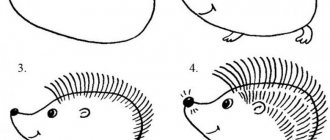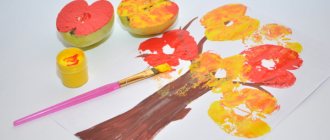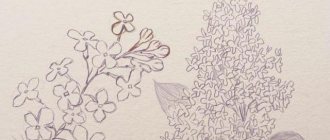Color science for children
All adults are well aware that the world is filled with many colors and their shades, but small children of kindergarten age are not even aware of this variety of colors until they are told and shown about it.
The science and technique of studying color variations with a child, or with a novice artist, is called color science. To explain to your child the number and names of colors, you need to prepare properly, for which you will need to stock up on the following available materials:
- Colored paper and pencils;
- Paints;
- Colored cubes, or parts of a construction set;
- In order to explain the names and number of colors to a girl, you can try to buy multi-colored bows or hairpins; a boy will most likely learn colors better using the example of cars. With the help of toys, color learning activities with children can be fun and interesting.
Color science for children. Where to begin
Studying color science with children should begin with a story about how people are surrounded by colors throughout their lives; as an example, you can ask the child to name the color of the clothes they are currently wearing. If the child copes with this task, it is necessary to continue the story and explain that there are only three pure colors, they are considered yellow, red and blue, while the rest of the colors are just derivatives of those listed.
You can also use paper and paints, mix blue with yellow, resulting in green, which must be clearly demonstrated to children.
Continuing the lesson, you need to name the most common colors, also telling the children that the rainbow contains the most colors - as many as 7, after which you should ask the children to draw a rainbow using brushes or pencils. You can also suggest making a rainbow from sheets of colored paper.
Teaching the basics of color science to the youngest children can begin by playing with cars, cubes, and dolls, during which each participant who receives a toy must name as many colors as possible in which it is painted. When conducting such games, it is important to remember that all auxiliary materials, including toys, must be provided for children of a particular age, and also be safe.
Color science assignments for children
After repeating the names of colors with the children several times, and also, if possible, watching additional educational cartoons that are easy to find on the Internet, the teacher or parent should invite the kids to work with colors on their own, using several of the following tasks on color science for children:
- Kids who are encountering the concept of color for the first time can color in a coloring book that provides a clear example of how the drawing should look;
- Children from 5 to 8 years old can color the same coloring page, but without an example, provided that it was discussed with them in advance why this or that object belongs to a certain color.
- Children should also be encouraged to try themselves in making their own flowers using brushes and paints. Mom or a teacher can give a task to get orange, lilac, pink and other colors.
A small color mixing scheme
It is important to explain to children that the color of the paints depends on how much water they add to them; the more, the lighter the shade.
In the future, invite your child to draw up a color wheel, starting with the primary colors, gradually adding new colors for a smoother transition.
You can end a game or lesson on learning colors with praise for the most successfully completed tasks and drawings.
It is very important that the study of color science takes place in a relaxed atmosphere; it is quite possible to organize teaching the basics of color science for children on the street, where a large number of color shades will make it possible to more fully and easily explain their meaning and name to children.
Concepts
The first thing that should be mentioned is the basics of color science. This is the science of color, which contains systematized information from various studies: physics, physiology, psychology. These areas study the phenomenon of shades, combining the results obtained with data on philosophy, aesthetics, history, and literature. Scientists have been studying color as a cultural phenomenon for a long time.
But coloristics is a more in-depth study of color, its theory and application by humans in various fields of activity.
Properties
It is worth understanding that there are incompatible colors. Although this concept is quite controversial. The thing is that if you take bright red and the same green, the symbiosis will look very provocative. Each of them tries to dominate the other, which results in dissonance. Although such an example does not mean that it is impossible to harmoniously combine red and green. To do this you need to understand the properties of color.
A color tone is a collection of shades that belong to the same color spectrum. Saturation is the degree of fade. Lightness is the approximation of a hue to white and vice versa. Brightness is the degree of proximity of a hue to black.
Chromatic and achromatic colors are also distinguished. The second ones include white, black and shades of gray. To the first - all the rest. All these properties can affect the compatibility and harmony of shades. If you make the green less bright and a little faded, and make the red calmer by increasing the lightness, then these two supposedly incompatible shades can harmoniously combine.
Religion in color
Western Europe in the Middle Ages looked at the basics of color science from the side of religion. At that time, other shades began to appear that had not previously been mistaken for the main ones. White began to symbolize Christ, God, angels, black - the underworld and the Antichrist. Yellow meant enlightenment and the work of the Holy Spirit, and red meant the Blood of Christ, fire and the sun. Blue symbolized the sky and the inhabitants of God, and green symbolized food, vegetation and the earthly path of Christ.
At this time, the same thing is happening with color in the Near and Middle East. This is where Islam gains influence. Basically, the meaning of colors remains the same. The only thing is that green becomes the main one and symbolizes the Garden of Eden.
Emotions
A very long time ago, scientists were able to understand that any shade of the primary color can influence a person’s emotions. Goethe first spoke about this in 1810. Later, scientists found that the human psyche is connected with external reality, which means that the perception of color can also influence emotions.
The next step in this research was the discovery that each tone was associated with a specific emotion. Moreover, this theory manifests itself almost from birth. It also became clear that there is a certain color code that relates to a number of emotions. For example, sadness, fear, fatigue, everything can be described in black or gray. But joy, interest, shame or love are usually associated with a red tint.
In addition to its psychological effects, color has been studied under clinical supervision. It turned out that red excites, yellow invigorates, green reduces blood pressure, and blue calms. It also all depends on the properties of the shade. If it is a calm red, then it can symbolize joy and love, if it is dark and bright, then blood and aggression.
The basics of color science and coloristics are very complex sciences. They are difficult to fully understand, since everything here is quite relative and subjective. Color can affect one person in different ways; some people are not affected by shades at all. Some artists may find the combination of purple and yellow very harmonious, while others may find it disgusting and contradictory.
Becoming
Starting a journey through the history of color, we need to return to the Ancient East. At that time there were 5 primary colors. They symbolized the four cardinal directions and the center of the earth. China stood out for its special brightness, naturalness and color. Later, everything changed, and monochrome and achromatic painting began to be observed in the culture of this country.
India and Egypt were even more developed in this regard. Two systems were observed here: a ternary one, which contained the main colors at that time (red, black and white); and also Vedic, based on the Vedas. The latter system was deepened in philosophy, so it contains red, symbolizing the eastern rays of the Sun, white - the rays of the South, black - the rays of the West, very black - the rays of the North and the invisible - the center.
In India, great importance was paid to the design of palaces. Traveling around the world, even now you can see that white, red and gold were often used. Over time, yellow and blue began to be added to these shades.
Harmony
It is worth noting that the Itten circle not only helps to create colors, but also combines them advantageously. This is needed not only by artists, but also by designers, fashion designers, makeup artists, illustrators, photographers, etc.
The combination of colors can be harmonious, characteristic and uncharacteristic. If you take opposite shades, they will look harmonious. If you choose colors that occupy sectors every other, you get characteristic combinations. And if you choose related colors that are located in a circle one after another, you will get uncharacteristic connections. This theory refers to a sector of seven colors.
In the Itten circle, this principle also works, but somewhat differently, since it is worth considering that there are 12 shades here. Therefore, in order to get two-color harmony, you should take tones that are opposite each other. Three-color harmony is obtained if an equilateral triangle is inscribed in a circle; using the same method, rectangular harmony is obtained, but inside we inscribe a rectangle. If you place a square within a circle, you get four-color harmony. The hexagon is responsible for the six-color combination. In addition to these options, there is an analog harmony that is formed if we take chromatic colors of a yellow hue. For example, this is how we can get yellow, yellow-orange, orange and red-orange.
Modern performance
The basics of color science led man to simplify the previous attempts of scientists. After Runge's globe, there was Ostwald's theory, in which he used a circle with 24 colors. Now this circle remains, but has been halved.
The scientist Itten was able to develop the ideal system. His circle consists of 12 colors. At first glance, the system is quite complicated, although you can figure it out. There are still three main colors here: red, yellow and blue. There are second-order composite colors that can be obtained by mixing the three primary colors: orange, green and violet. This also includes third-order composite colors, which can be obtained by mixing the primary color with second-order composites.
Which range is better and how to harmonize the color?
In color science there is such a thing as executing a painting in warm and cold colors. By mixing 2 chromatic colors in different combinations, you can get shades with different warm and cold undertones. Combinations of shades with the same undertone are considered ideal. Not all colors can be harmoniously combined in one picture.
For example, cold purple harmonizes perfectly with cold green; the connecting “thread” is the blue undertone. But cold purple and warm green don’t go together at all; the blue clashes with the yellow undertone in the green.
Therefore, it is better to use paint colors based on warmth and coldness. For example, you can depict a similar plot in different scales and compare.
Color science in painting - warm and cold colors
Agree that warm colors create a completely different feeling than cold ones. In the first version, warm notes are chosen to create the impression of a hot day. At the same time, the second image in cool colors creates the feeling of a cold morning.
Knowing all the basics of color science, we can create the mood of a painting. Additionally, read about color schemes and the harmonious combination of colors in a painting.
New theories
The 19th century in Europe leads us to naturalism and impressionism. The first style proclaims complete correspondence of colors, shades and tones, while the second is based only on the transfer of images. At this time, painting with the basics of color science appeared.
Then the theory of Philip Otto Runge arises, which distributes the system according to the principle of a globe. Pure primary colors are located along the equator of the “globe”. The upper pole is occupied by white, the lower pole by black. The rest of the space is taken up by mixtures and shades.
The Runge system is very calculated and has its place. Each square on the globe has its own “address” (longitude and latitude), so it can be determined by calculation. Others followed in the footsteps of this scientist and tried to improve the system and create a more convenient option: Chevreul, Goltz, Betzold.





